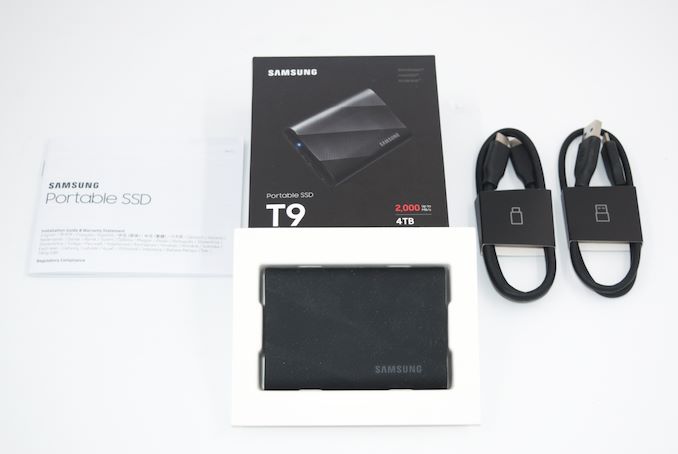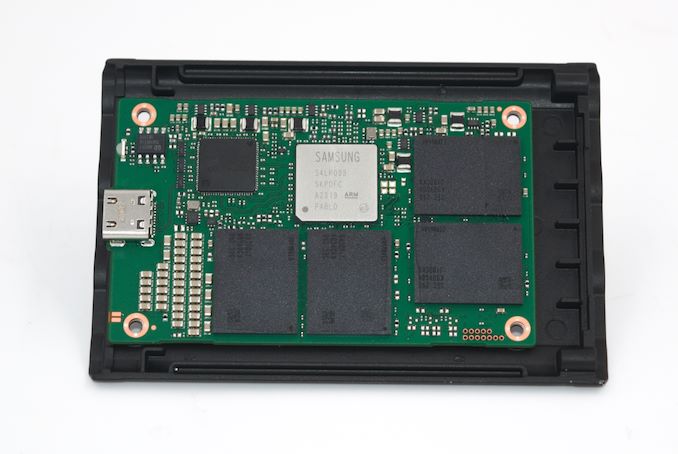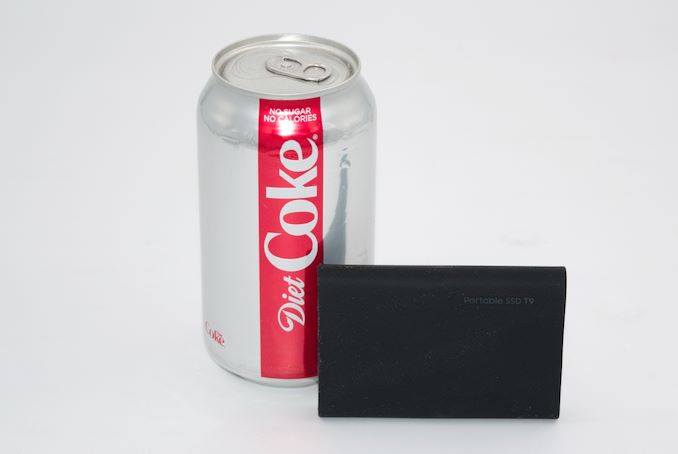
Original Link: https://www.anandtech.com/show/21079/samsung-t9-portable-ssd-review-a-20-gbps-pssd-for-prosumer-workloads
Samsung T9 Portable SSD Review: A 20 Gbps PSSD for Prosumer Workloads
by Ganesh T S on October 3, 2023 10:00 AM EST- Posted in
- Storage
- SSDs
- Samsung
- External SSDs
- USB 3.2 Gen 2x2
- Portable SSDs
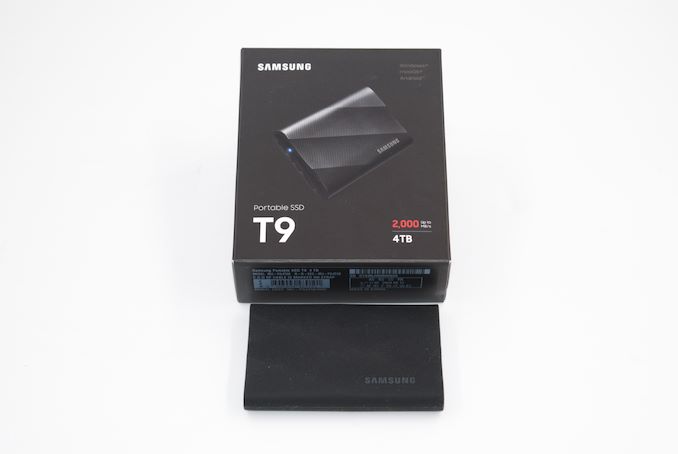
Samsung's portable SSD lineup has enjoyed significant market success since the launch of the T1 back in 2015. Despite the release of the Thunderbolt-capable X5 PSSD in 2018, the company has been focusing primarily on the mainstream market with its T series drives.
The first set of PSSDs from Samsung incorporated a SATA SSD behind a USB 3.2 Gen 1 bridge chip. With the T5 in 2017, the company moved to a USB 3.2 Gen 2 bridge while retaining the SATA SSD. In the T7 Touch launched in 2020, the SATA component was replaced by a NVMe SSD and the USB 3.2 Gen 2 SATA bridge was replaced by a NVMe one. The T7 series was augmented with IP65-rated models (the T7 Shield) in 2022. Despite the same T7 moniker, the Shield's use of newer NAND enabled improvements in both latency and power consumption.
Samsung is introducing the 2 GBps-class Portable SSD T9 today. Equipped with a USB 3.2 Gen 2x2 (20 Gbps) interface, the PSSD advertises double the performance of the T7 Shield. The company sent over the highest capacity version (4 TB) to put through our rigorous evaluation routine for direct-attached storage devices. The review below presents an in-depth investigation into the design and performance profile of the Samsung Portable SSD T9.
Introduction and Product Impressions
External bus-powered storage devices have grown both in storage capacity as well as speeds over the last decade. Thanks to rapid advancements in flash technology (including the advent of 3D NAND and NVMe) as well as faster host interfaces (such as Thunderbolt and USB 3.x / USB4), we now have palm-sized flash-based storage devices capable of delivering 3GBps+ speeds. While those speeds can be achieved with Thunderbolt, mass-market devices have to rely on USB. Within the USB ecosystem, USB 3.2 Gen 2 (10 Gbps) is fast becoming the entry level for thumb drives and portable SSDs. USB 3.2 Gen 2x2 (20 Gbps) got off to a slow start, but recent computing platforms from both Intel and AMD have started to support it on the host side. The introduction of native USB 3.2 Gen 2x2 flash controllers such as the Phison U18 and Silicon Motion SM2320 has enabled PSSD vendors to bring low-cost power-efficient 20 Gbps external drives to the market.
Broadly speaking, there are five distinct performance levels in this market:
- 2GBps+ drives with Thunderbolt 3 or USB4, using NVMe SSDs
- 2GBps drives with USB 3.2 Gen 2x2, using NVMe SSDs or direct USB flash drive (UFD) controllers
- 1GBps drives with USB 3.2 Gen 2, using NVMe SSDs or direct UFD controllers
- 500MBps drives with USB 3.2 Gen 1 (or, Gen 2, in some cases), using SATA SSDs
- Sub-400MBps drives with USB 3.2 Gen 1, using UFD controllers
Within each of these levels, there is further segmentation into entry-level, mid-range, and premium based on the choice of internal components. The Samsung Portable SSD T9 4 TB we are looking at today belongs to the second category in the above list. The T9 package comes with the main unit, an installation guide, and two 45 cm USB cables. The Type-C to Type-C one supports 20 Gbps speeds, while the Type-C to Type-A is restricted to 10 Gbps speeds. The main unit has a LED indicator and a Type-C female port (USB 3.2 Gen 2x2 is supported only with Type-C ports).
The main unit has a rubber sleeve, providing it with a bit of ruggedness (withstanding drops, etc.). However, the T9 does not have an IP rating. Disassembling the unit is fairly trivial - after removal of the sleeve, we can see four screws holding the two aluminum blocks together. Other than these, there are four screws hidden behind the label on either end as shown in the gallery below. The PSSD's main board is sandwiched between the two blocks.
This design is slightly different from the earlier T series drives. We see a more thorough thermal solution with plenty of thermal pads spread out across the board. The aluminum blocks also have raised profiles on the inside in order to ensure good contact with the heat generating components of the board.
The board itself is very similar to the T7 Shield we reviewed earlier this year. The NVMe SSD controller is the same Pablo silicon, and the NAND package markings point to the use of the same 128L / 136T 6th Gen. V-NAND. The NVMe segment is DRAM-less. Compared to the 4 TB T7 Shield's board, the only change is the replacement of the ASMedia ASM2362 by the ASMedia ASM2364 USB 3.2 Gen 2x2 - PCIe 3.0 x4 NVMe bridge chip.
This review compares the Samsung T9 against a host of other USB 3.2 Gen 2x2 PSSDs reviewed earlier. A quick overview of the internal capabilities of theese PSSDs is given by CrystalDiskInfo. The Samsung PSSD T9 supports full S.M.A.R.T passthrough, along with TRIM to ensure consistent performance for the drive over its lifetime.
| Comparative Direct-Attached Storage Devices Configuration | ||
| Aspect | ||
| Downstream Port | 1x PCIe 3.0 x4 | 1x PCIe 3.0 x4 (M.2 NVMe) |
| Upstream Port | USB 3.2 Gen 2x2 Type-C (Female) | USB 3.2 Gen 2x2 Type-C |
| Bridge Chip | ASMedia ASM2364 | ASMedia ASM2364 |
| Power | Bus Powered | Bus Powered |
| Use Case | 2GBps-class, sturdy palm-sized high-performance portable SSD with a Type-C interface | Premium 2GBps-class, compact, and sturdy portable SSD in a gumstick form-factor targeting the gaming market |
| Physical Dimensions | 88 mm x 60 mm x 14 mm | 118 mm x 62 mm x 14 mm |
| Weight | 122 grams | 115 grams (without cable) |
| Cable | 45 cm USB 3.2 Gen 2x2 Type-C (male) to Type-C (male) 45 cm USB 3.2 Gen 2 Type-C (male) to Type-A (male) |
30 cm USB 3.2 Gen 2x2 Type-C to Type-C 30 cm USB 3.2 Gen 2 Type-C to Type-A |
| S.M.A.R.T Passthrough | Yes | Yes |
| UASP Support | Yes | Yes |
| TRIM Passthrough | Yes | Yes |
| Hardware Encryption | Yes | Not Available |
| Evaluated Storage | Samsung 136L V-NAND (6th Gen.) | Western Digital SN750E PCIe 3.0 x4 M.2 2280 NVMe SSD SanDisk / Toshiba BiCS 4 96L 3D TLC |
| Price | $440 | USD 210 |
| Review Link | Samsung T9 Portable SSD 4TB Review | WD_BLACK P50 Game Drive SSD 1TB Review #1 (2020) WD_BLACK P50 Game Drive SSD 1TB Review #2 (2021) |
Prior to looking at the benchmark numbers, power consumption, and thermal solution effectiveness, a description of the testbed setup and evaluation methodology is provided.
Testbed Setup and Evaluation Methodology
Direct-attached storage devices (including portable SSDs) are evaluated using the Quartz Canyon NUC (essentially, the Xeon / ECC version of the Ghost Canyon NUC) configured with 2x 16GB DDR4-2667 ECC SODIMMs and a PCIe 3.0 x4 NVMe SSD - the IM2P33E8 1TB from ADATA.
The most attractive aspect of the Quartz Canyon NUC is the presence of two PCIe slots (electrically, x16 and x4) for add-in cards. In the absence of a discrete GPU - for which there is no need in a DAS testbed - both slots are available. In fact, we also added a spare SanDisk Extreme PRO M.2 NVMe SSD to the CPU direct-attached M.2 22110 slot in the baseboard in order to avoid DMI bottlenecks when evaluating Thunderbolt 3 devices. This still allows for two add-in cards operating at x8 (x16 electrical) and x4 (x4 electrical). Since the Quartz Canyon NUC doesn't have a native USB 3.2 Gen 2x2 port, Silverstone's SST-ECU06 add-in card was installed in the x4 slot. All non-Thunderbolt devices are tested using the Type-C port enabled by the SST-ECU06.
The specifications of the testbed are summarized in the table below:
| The 2021 AnandTech DAS Testbed Configuration | |
| System | Intel Quartz Canyon NUC9vXQNX |
| CPU | Intel Xeon E-2286M |
| Memory | ADATA Industrial AD4B3200716G22 32 GB (2x 16GB) DDR4-3200 ECC @ 22-22-22-52 |
| OS Drive | ADATA Industrial IM2P33E8 NVMe 1TB |
| Secondary Drive | SanDisk Extreme PRO M.2 NVMe 3D SSD 1TB |
| Add-on Card | SilverStone Tek SST-ECU06 USB 3.2 Gen 2x2 Type-C Host |
| OS | Windows 10 Enterprise x64 (21H1) |
| Thanks to ADATA, Intel, and SilverStone Tek for the build components | |
The testbed hardware is only one segment of the evaluation. Over the last few years, the typical direct-attached storage workloads for memory cards have also evolved. High bit-rate 4K videos at 60fps have become quite common, and 8K videos are starting to make an appearance. Game install sizes have also grown steadily even in portable game consoles, thanks to high resolution textures and artwork. Keeping these in mind, our evaluation scheme for direct-attached storage devices involves multiple workloads which are described in detail in the corresponding sections.
- Synthetic workloads using CrystalDiskMark and ATTO
- Real-world access traces using PCMark 10's storage benchmark
- Custom robocopy workloads reflective of typical DAS usage
- Sequential write stress test
In the next section, we have an overview of the performance of the Samsung Portable SSD T9 in these benchmarks. Prior to providing concluding remarks, we have some observations on the PSSD's power consumption numbers and thermal solution also.
Performance Benchmarks
Benchmarks such as ATTO and CrystalDiskMark help provide a quick look at the performance of the direct-attached storage device. The results translate to the instantaneous performance numbers that consumers can expect for specific workloads, but do not account for changes in behavior when the unit is subject to long-term conditioning and/or thermal throttling. Yet another use of these synthetic benchmarks is the ability to gather information regarding support for specific storage device features that affect performance.
Samsung claims speeds of up to 2000 MBps for the T9 4TB version. Our ATTO testing configuration manages to reach numbers quite close to the advertised one for reads, while the writes are a bit lower. However, we only use a single queue depth of 4 - so, it is only representative of a small subset of real-world workloads. It does allow the visualization of change in transfer rates as the I/O size changes, with optimal performance being reached around 1 MB for a queue depth of 4.
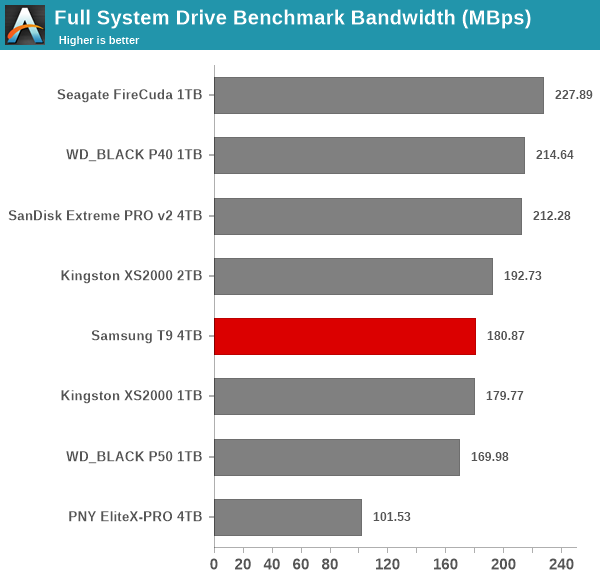
The T9 finds itself in the bottom half of the pack, but the absolute scores for all PSSDs without DRAM are fairly close to each other.
Miscellaneous Aspects and Concluding Remarks
The performance of the PSSDs in various real-world access traces as well as synthetic workloads was brought out in the preceding section. We also looked at the performance consistency for these cases. Power users may also be interested in performance consistency under worst-case conditions, as well as drive power consumption. The latter is also important when used with battery powered devices such as notebooks and smartphones. Pricing is also an important aspect. We analyze each of these in detail below.
Worst-Case Performance Consistency
Flash-based storage devices tend to slow down in unpredictable ways when subject to a large number of small-sized random writes. Many benchmarks use that scheme to pre-condition devices prior to the actual testing in order to get a worst-case representative number. Fortunately, such workloads are uncommon for direct-attached storage devices, where workloads are largely sequential in nature. Use of SLC caching as well as firmware caps to prevent overheating may cause drop in write speeds when a flash-based DAS device is subject to sustained sequential writes.
Our Sequential Writes Performance Consistency Test configures the device as a raw physical disk (after deleting configured volumes). A fio workload is set up to write sequential data to the raw drive with a block size of 128K and iodepth of 32 to cover 90% of the drive capacity. The internal temperature is recorded at either end of the workload, while the instantaneous write data rate and cumulative total write data amount are recorded at 1-second intervals.
| CrystalDiskMark Workloads - Power Consumption | |
| TOP: | BOTTOM: |
 |
|
 |
|
The peak power consumption (6.7W) is quite competitive against all other PSSDs that are not based on native flash controllers. The lowest idle power number of 0.25W is also the least among such PSSDs. However, the PSSDs based on controllers like the Phison U18 and Silicon Motion SM2320 have a true deep-sleep mode where the bus power consumption is essentially non-existent. Unfortunately, the Samsung T9 doesn't seem to have such a mode.
Final Words
The Samsung Portable SSD T9 is available for purchase today, with suggested pricing of $140 for the 1 TB version, $240 for the 2 TB, and $440 for the 4 TB SKU. At these prices, the value proposition does not look good for the T9. The SanDisk Extreme PRO v2 that wins out on most of the benchmarks, and has similar thermal profile is priced at $300. We are aware that recent batches of the SanDisk PSSD have resulted in extreme consumer dissatisfaction, but we believe Western Digital has already addressed the problem if they are confident enough to continue selling it. The Crucial X10 Pro 4 TB is priced at $290, but we have not included it in the comparison list in this review, as that PSSD is still under evaluation. The other PSSDs are all based on native controllers and can't match the T9's performance profile. Despite their much lower price points, they do not contribute to the comparative value proposition discussion.
The Samsung Portable SSD T9 is a valuable addition to the company's T series lineup. It retains the sleek and attractive form-factor of its predecessors, and also adds some ruggedness with its re-designed rubber sleeve. Subjectively speaking, the new sleeve with its carbon pattern design is more functional and provides a solid feel in the hand compared to the T7 Shield.
The T9's pseudo-SLC cache size of around 175 GB is more than enough for most consumers, and likely for a large number of prosumers too. It needs to be noted that a USB 3.2 Gen 2x2 host is needed to take full benefit of the PSSD's performance. However, thanks to USB's backward compatibility, the T9 can be used with a wide variety of systems - including those with just USB 2.0 ports.
Samsung is also releasing a new version of their Magician software this month. The new version unifies the product maintenance aspect for a range of internal SSDs, memory cards, and PSSDs as well. This will also include data migration support, counterfeit checking capabilities, and the ability to set a password for the drive (and take advantage of the hardware encryption capabilities).
Compared to the Samsung X5, the T9 is able to perform reasonably well across our entire test suite. The launch pricing is a bit out of touch with market reality (given the price of the 20 Gbps PSSDs from Samsung's competitors). Pricing the T9 4 TB version around $300 would have resulted in a much better value proposition. As it stands, the performance of the T9 is passable given its DRAM-less nature. Had Samsung opted for a DRAM-equipped NVMe SSD component with the latest NAND instead of retaining the one from the T7 Shield, the T9 could have even be in the competition for the performance crown.

